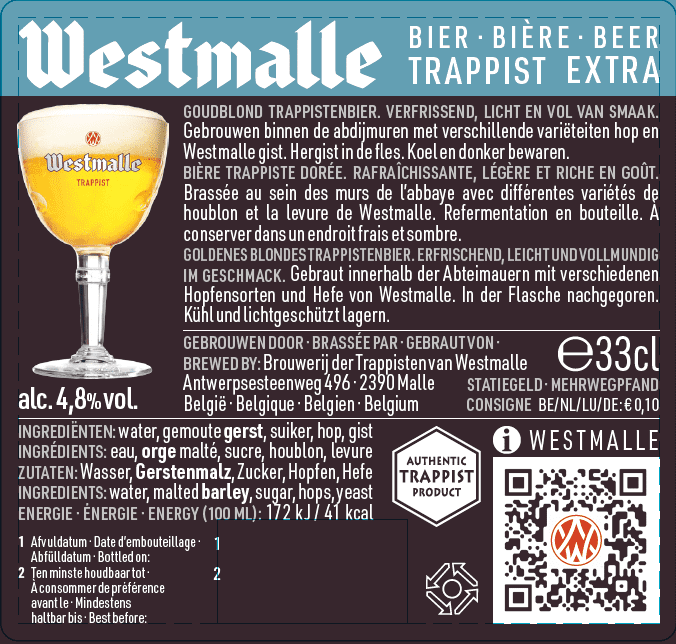
Everything you need to know about the shelf life of Trappist beer
For beer lovers, Trappist beer is a fascinating subject. Its complex flavours and rich history make them a true delight. But did you know that Trappist beers, like any other beer, change over time? Label dates, such as bottling date and BBE date, play a crucial role in understanding the age and shelf life of Trappist beer. Learn how these dates affect the taste and quality of your favourite trappist and discover why some bottles are worth saving for special moments, even if the dates on the label are in the past.

What do the dates on my label mean?
The label of your bottle of Trappist beer contains a lot of information that we as a brewer give to our consumers. These include an ingredient declaration (what exactly is in your beer), who made the beer and where, and two different dates. The bottling date and the BBE date, or ‘Best before’ date.
With these two dates, you can find out the age and shelf life of your beer.
What if my beer has expired?
How exactly does that work? The bottling date and the BBE date are two years apart, meaning your bottle of beer will keep for at least two years after bottling. But if you store it properly, it can actually last even longer.
The BBE date listed on your bottle is a guideline to determine the approximate date at which the beer will change in flavour and intensity. Up to the BBE date, we guarantee that a beer will retain its characteristic properties if stored correctly, but this does not necessarily mean that your beer will no longer be tasty or safe after this date. However, the colour, aroma or flavour may evolve. The hop aromas and bitterness will diminish a little and the flavour will soften. If you want to experience the beer as it should be, you should make sure you drink it before the best-before date.
Depending on the type of beer, in many cases it is totally okay to drink your bottle after the expiration date. With relatively darker beer (such as our Dubbel) or beer with a higher alcohol content (such as our Tripel), you can generally hide a few bottles in the back of your cellar to drink later.
So why is there an expiry date on our bottles of Trappist beer? It is mandatory to put a best-before date on a bottle of beer as a guideline. This was introduced in the EU in the year 2000. As such, you could see our best-before date as a recommendation. Within that period, we consider our beers optimal. The beer will not be bad after two years, but it will definitely have evolved.

What factors influence flavour?
It’s strange, isn’t it, to keep using food after its expiry date? This is due to a number of factors, such as the presence of alcohol and lack of oxygen, (re-)fermentation and the method of storage.
When oxygen is absorbed into the beer, this is called oxidation. This changes the flavour of your beer. Contact with oxygen is avoided as much as possible throughout the brewing process. During the (re)fermentation process, the yeast cells consume the oxygen in the beer. This ensures less oxidation and so the flavour is better preserved.
In beers where re-fermentation takes place in the bottle – like our Westmalle! – the chance of oxidation is much lower. When sugar and a little extra yeast are added to the beer before bottling, the yeast in the beer will ferment the sugar. This process is called re-fermentation. This consumes the oxygen in the beer in the bottle, which is now sealed with a crown cap. In the air neck, the volume between beer surface and crown cap, there can still be oxygen even at the end of secondary fermentation that migrates into the beer and can still cause oxidation. The air neck is minimised on our filling machine by frothing the beer just before the crown cap is placed.
What is the best way to store my beer?
If the BBE date on your bottle has expired, a lot depends on the conditions in which you stored your bottle. Here are some recommendations to keep your beer at its best for as long as possible.
Three tips for storing beer:
- Store your bottles upright,
- In a dark place,
- And at a constant temperature of 2 to 5°C.
Heat speeds up oxidation reactions and UV light accelerates flavour change. This explains why beer is kept in dark bottles.
And what about the foam?
A beer with little or even no foam, can still be safely drunk. Older beers will usually have lower foam retention.
What do I do with beer that really is too old?
In case you really don’t like beer that is past its expiry date, you can just wash it away in the sink. But you can also put it to good use for other things!
- Make an insect trap
Of course, one of the biggest summer inconveniences are the wasps or fruit flies that fly all around you inside and outside. By turning a bottle into an insect trap, you can use a layer of stale beer to attract the critters just fine. - Remove rust
We haven’t tried it ourselves yet, but according to grandmother’s recipe, beer also removes rust. Put your silverware in a bowl and pour some beer over it. Soak it overnight and the next day the rust is said to be gone.
Source: Brouwpunt
Conclusion
So don’t throw away a Trappist beer whose BBE date has passed too soon. Use your senses to taste, smell, hear and see the quality of the beer. Pay attention to the familiar ‘psssst’ sound when you open it.
Cheers!